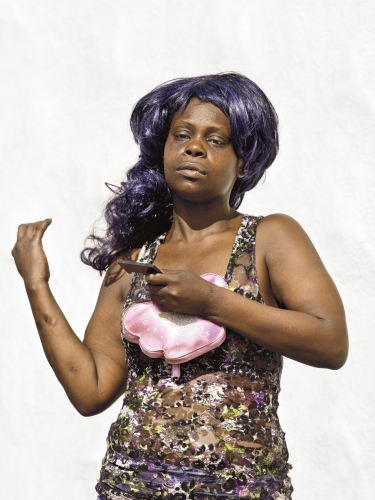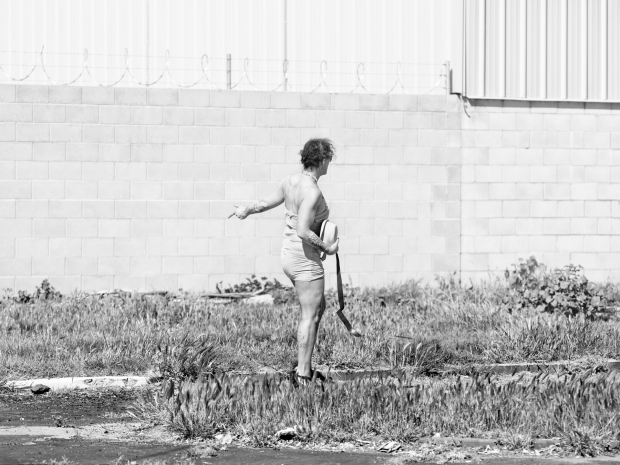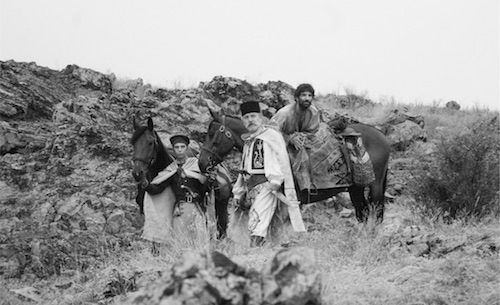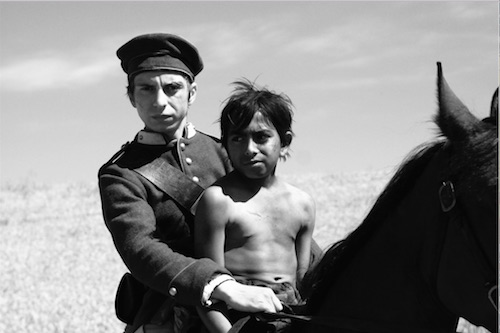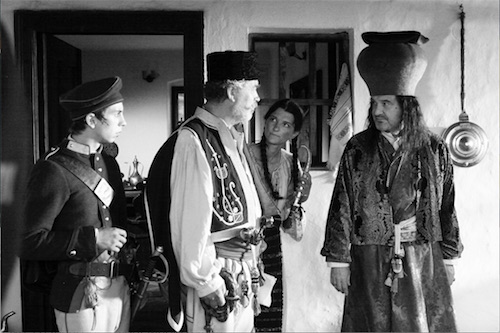- 8 years ago
-
I came across Katy Grannan‘s photographs at Salon 94 after visiting the New Museum next door. While individually they remain striking portraits, albeit not vastly unique in the photographic spectrum, what makes her work important lies in her documentary approach to the sleepiness, strangeness, and pathos of Modesto, California.
Also the setting of her upcoming documentary, The Nine, the pieces ranged from large-scale individual portraits, to landscapes, and video clips. The portraits are blazing in their preciseness and their size allows for the individuals to tower over the viewers, commanding the most space and attention in the room they are in. The men are shirtless, and the women sport outfits that look like they’re from the 80’s. A look of disillusionment permeates through their faces, however, and in the case of the women, it betrays the vibrancy of their clothing.
What’s really at the heart of Grannan’s work is a commentary on the American class system – ripe in the media these days thanks to shows like Making a Murderer – and “the other side of the American Dream.” Modesto was the location in The Grapes of Wrath and Dorothea Lange’s photograph Migrant Mother, both gripping portrayals of The Great Depression’s physical and emotional effects on the psyche and physicality. And essentially, Grannan’s work from Modesto serves as the setting of our contemporary depression. And the photographs speak for themselves in this regard – the subjects are present but not fully. People bathe in lakes, lounge in trees, and wait along the roadside. And in most, the glaring light of the sun literally and metaphorically shines light on the destitute landscape. And whereas Lange’s photograph is of a woman doing what she can to make it work, Grannan’s series rather shows our modern depression as individuals who have plateaued.
Though the show is closed now, I think it’s important to keep Grannan’s works in mind due to their aesthetic qualities but even more so as she uses her craft to meld art with socio-economic issues many in the art world are to keen to forget/ignore.
-Sabeena Khosla-
Latest News
-
Enter Ziggy Stardust.
Bowie’s beloved persona began with the release of 1972’s The Rise and Fall of Ziggy Stardust and the Spiders from Mars. Stardust starred as the record’s fictional alien rock star who arrived on Earth just as it received the news that the world would end in five years. In the album’s opening track, which is aptly titled “Five Years”, Stardust laments about the planet’s fate while walking amongst it’s doomed species. He resembled them in shape, but is extreme in all other aspects. He had wild hair, outlandish outfits, and an overall zeal that made him an eccentric, especially compared to the cop, soldier, priest, mother and newscaster that populate the rest of the song.
In a 1974 interview with “Beat Godfather” William S. Burroughs, Bowie described the scene:
- 8 years ago
-
Romania’s official 2016 Academy Awards entry for Best Foreign Language Film, Aferim! is an unconventional and beautifully shot black-and-white movie that is both reminiscent of an American Western and exotic in its depiction of a bygone (and perhaps not so bygone) foreign culture. The episodic tale, which takes place in 1835 Wallachia (a region in Romania), follows a lawman and his son as they traverse a desolate landscape in search of an escaped gypsy slave.
Directed by Radu Jude and co-written by novelist Florin Lazarescu, Aferim! (which means “Bravo!”) is based on actual accounts of gypsy slavery. Though often comedic (the dialogue is full of crudely funny banter), it serves as a semi-historical commentary on Romania’s anti-Roma sentiment, which is still very much in evidence today. It also starkly depicts the ridiculous prejudices that people of one nationality or religion have for others, in addition to other forms of bigotry.
Constable Costandin (Teodor Corban) and his teenage son Ionitā (Mihai Comānoiu) first come upon an abbey on their travels, where they cross themselves and light candles like good Catholics, though Costandin has already cruelly berated an old woman and threatened a bunch of local gypsies. He’s a scrappy, equal-opportunity offender, who hurls insults at almost everyone he comes across – especially poor “crows” (gypsies) – or denigrates them behind their backs. In contrast, Ionitā is more reserved and thoughtful. The two carry a mandate for the capture of Carfin, a slave who has stolen money and run away from his master, a boyar.
When they help a stranded priest, Costandin asks him, “Gypsies: are they people or Satan’s spawn,” which leads the holy man to expound happily on the flaws of various nationalities (except for Romanians, who “love, honor and suffer”). “Lovely thoughts, father,” says Costandin, who himself seems no better. “You’re not a sodomite, are you,” he asks his son at one point. “Because if you are, I’ll drown you with my own hands.”
They encounter various individuals as they navigate the rugged terrain, including a rival lawman who is bribed to reveal the fugitive’s hiding place. There they find both Carfin (Cuzin Toma) and an escaped child slave, both of whom beg not to be returned to their owners. It turns out that Carfin had an affair with the boyar’s wife and believes he will be killed; the child was beaten by his owner. But Costandin pays them no heed.
He and Ionitā take both Carfin and the boy, the former shackled and slung over Costandin’s horse. The group comes across Turks in a carriage and Costandin politely gives them wrong directions (“I hate the Ottomans, nothing but beasts”). Carfin, who has travelled and seen something of the world, tell his story, which amuses Costandin, but “We have no concern for your life,” declares the constable, trying to remain detached.
In one surreal scene, they come upon a ragged carnival/slave auction that includes a crude ferris wheel and a violent Punch and Judy show. Starving slaves beg to be bought, and the young boy is ultimately sold by Costandin to a priest. The constable gets drunk at the village inn, waxes philosophical and gets sentimental; he gives Carfin food and wine, and arranges a prostitute for his son and himself. Amid the drunken singing and general merriment, Carfin begs again to be released and Ionitā asks if they can let him go. Costandin refuses, but agrees to defend the slave to his boyar when they get back.
The trio return home and bring Carfin to the boyar’s house; at this point the movie sobers up and becomes tense as we await the slave’s fate. True to his word, Costandin first talks to the owner’s wife and hears her unhappy story, then finally speaks to the wealthy boyar and asks him to spare the slave. But things take a horrific turn, all the more appalling after all the comic banter.
A combination road-trip farce and dark historical account, Aferim! is an unusual and affecting film that uniquely addresses the kind of ages-old prejudices that continue to devastate the world.
Aferim! is playing at the Angelika Film Center and Lincoln Plaza Cinemas.
—Marina Zogbi
- 8 years ago
-
David Bowie was a musician of almost immeasurable influence. His last name echoes amongst the likes of Fitzgerald, Lennon, Presley, Ramone, Nicks and Cobain as one of the people responsible for music today. For almost half a century, he graced genre after genre with his albums, exploring each with an obsessive eye. From folk rock to krautrock-laced funk to art rock and experimental, there seemed to be no undertaking that Bowie couldn’t master. He fathered sub-genres and inspired others to do the same.
He became known not only for his songs, which climbed the charts like English ivy, but also his oddities. His hair, his face paint, his outlandish outfits. During the era of Ziggy Stardust from his station in glam rock, he made being an outsider ‘in’. He challenged gender norms, racism, politics, and a whole manner of preconceived notions of how music was supposed to be. He was an idol, a style icon, a pop star, the star of your favorite childhood movie and in his final effort he was a blackstar.
Bowie’s final album Blackstar was released on January 8th, coinciding with his 69th birthday. The record is a short, emotional, and strange departure from the various forms of pop that Bowie is best known for, but fittingly so. Bowie was never going to be predictable. Two days after the album’s release, the seemingly immortal Bowie died after a long battle with cancer. Blackstar then took on its intended meaning. It was his swan song. With every subsequent listen it seemed increasingly obvious that the Starman was hinting at his impending death the entire time. He was also saying goodbye.
- 8 years ago
-
David Bowie was an incredible genius that has been a massive influence on the fashion world from ready-to-wear to high couture, trailblazing trends for both men and women alike.
Since news of David Bowie’s tragic death on Sunday, January 10 hit the internet the following Monday, a deluge of mournful tributes on sites like Twitter and Facebook have brought back to attention many of his gender-fluid, enigmatic looks throughout the music legend’s career, which span six decades.
His constant sartorial evolutions have left indelible mark on fashion, as evident in the multitude of status updates, images, and video, paying homage to Bowie.

